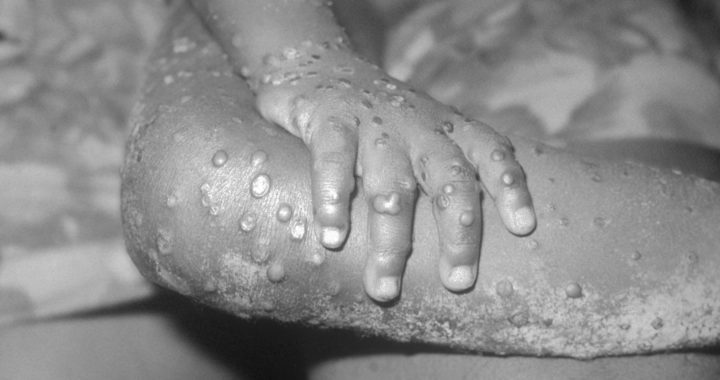Mpox, formerly known as monkeypox, is a zoonotic infectious disease caused by the mpox virus or MPOXV and is related to the smallpox. The virus belongs to the genus Orthopoxvirus in the Poxviridate family. It affects animals, including humans. Furthermore, because it is a zoonotic disease, the virus is transmitted from animals to humans, although there are cases of human-to-human transmission.
Note that mpox and smallpox have a close resemblance. Symptoms begin with fever, headache, muscle pains, swollen lymph nodes, and feeling tired, and followed by the appearance of rashes which develop into blisters and crusts. However, compared with smallpox, it results in milder rash and has a lower mortality rate.
The disease is endemic in Central and Western African countries. There have been recorded cases in western countries such as the United States. It gained widespread attention in May 2022 when countries in Europe such as the United Kingdom and Portugal documented and reported an outbreak that experts believed to have started in April of the same year.
Where Did Mpox Originate: The Origin of the Mpox Virus and the Discovery of the Mpox Disease
Origin in the Wild
Experts are not sure where the mpox virus originated or how it infected humans. Some have a working assumption that it has existed about 3000 years ago based on analyses of several ancient Egyptian mummies with smallpox-like rashes. However, this remains a debated issue because the presence of rashes might be caused by another virus from the Poxviridate family.
The wild animal reservoir of the virus remains unidentified as well. It already came to light when Danish virologist Preben von Magnus spotted the virus in laboratory crab-eating macaque or long-tailed macaque monkeys in 1958. These monkeys are native to Southeast Asia and have been used in laboratory settings for medical experiments.
Note that despite the name of the disease and the virus, monkeys are not the natural reservoir of the virus. Studies showed that the virus is primarily found in the tropical rainforest areas of Central and Western Africa. Several mammalian species have been documented as carriers. These include Gambian pouched rats and African squirrels.
Notable Outbreaks
Remember that the exact events leading to the first human case or the circumstances that allowed the virus to jump from animals to humans remain uncertain. What is clear is that the origin of the mpox disease in humans was a result of a spillover event in which the virus that originated from wild animals jumped to the human population due to animal-human interactions.
The first human cases of the mpox were recorded in the 1970s in the Democratic Republic of Congo. From 1970 to 1986, there were over 400 recorded cases in humans located in Zaire, which accounted for most of the cases, as well as in Liberia, Nigeria, Ivory Coast, and Sierra Leone. The disease was confined to African countries for a while.
However, the first mpox outbreak occurring outside Africa occurred in the United States in 2003, particularly in Illinois, Indiana, and Wisconsin, as well as in New Jersey. Experts traced the outbreak from an animal-to-human transmission. To be specific, the disease came from a prairie dog that got the virus from infected animals imported from Africa.
Investigators specifically pinned the origin of the virus on a shipment of animals from Ghana that arrived in Texas in April 2003. It contained about 800 small animals. Further investigations showed that two African giant pouched rats, nine dormice, and three rope squirrels were infected by the virus. Some of these infected animals were housed near prairie dogs.
2022 Mpox Outbreak
The United Kingdom confirmed a mpox outbreak on 6 May 2022. Epidemiologists noted that it began in a British resident who previously traveled to Nigeria where the disease was endemic. The exact origin of other mpox cases in the U.K. remains unknown. Several countries in Europe and elsewhere also reported outbreaks.
Hence, beyond the United Kingdom, there have been documented cases in other European countries such as Portugal, Sweden, and Belgium. The United States, Canada, and Australia also reported domestic cases. The World Health Organization held an emergency meeting on 20 May 2022 to discuss the outbreak and prepare for containment measures.
The origin of the mpox outbreak in the United Kingdom and other countries is puzzling because it seems as if people with no apparent connection with one another got infected. Several public health authorities have expressed concerns despite the low mortality rate of the disease and low transmission rate of the virus.
FURTHER READINGS AND REFERENCES
- Breman, J. G., Kalisa-Ruti, Steniowski, M. V., Zanotto, E., Gromyko, A. I., and Arita, I. 1980. “Human Monkeypox, 1970-1970.” Bulletin of the World Health Organization. 58(2): 165-182. PMID: 6249508
- Centers For Disease Control and Prevention. 2022. “Monkeypox in the United States.” Centers For Disease Control and Prevention. Available online
- Kozlov, M. 2022. “Monkeypox Goes Global: Why Scientists Are On Alert.” Nature. DOI: 1038/d41586-022-01421-8
- Meyer, H., Perrichot, M., Stemmler, M., Emmerich, P., Schmitz, H., Varaine, F., Shungu, R., Tshioko, F., and Formenty, P. 2002. “Outbreaks of Disease Suspected of Being Due to Human Monkeypox Virus Infection in the Democratic Republic of Congo in 2001.” Journal of Clinical Microbiology. 40(8). DOI: 1128/JCM.40.8.2919-2921.2002
- Sklenovská, N. and Van Ranst, M. 2018. “Emergence of Monkeypox as the Most Important Orthopoxvirus Infection in Humans.” Frontiers in Public Health. 9. DOI: 3389/fpubh.2018.00241

